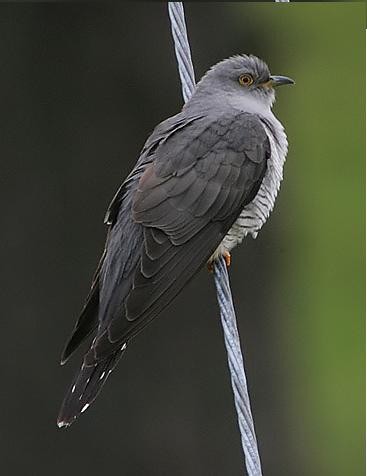Common Cuckoo
A species of Typical Cuckoos Scientific name : Cuculus canorus Genus : Typical Cuckoos
Common Cuckoo, A species of Typical Cuckoos
Botanical name: Cuculus canorus
Genus: Typical Cuckoos
Content
Description People often ask General Info
 Photo By Berichard , used under CC-BY-SA-2.0 /Cropped and compressed from original
Photo By Berichard , used under CC-BY-SA-2.0 /Cropped and compressed from original Description
The common cuckoo is 32–34 centimetres (13–13 in) long from bill to tail (with a tail of 13–15 centimetres (5.1–5.9 in) and a wingspan of 55–60 centimetres (22–24 in). The legs are short. It has a greyish, slender body and long tail, similar to a sparrowhawk in flight, where the wingbeats are regular. During the breeding season, common cuckoos often settle on an open perch with drooped wings and raised tail. There is a rufous colour morph, which occurs occasionally in adult females but more often in juveniles. All adult males are slate-grey; the grey throat extends well down the bird's breast with a sharp demarcation to the barred underparts. The iris, orbital ring, the base of the bill and feet are yellow. Grey adult females have a pinkish-buff or buff background to the barring and neck sides, and sometimes small rufous spots on the median and greater coverts and the outer webs of the secondary feathers. Rufous morph adult females have reddish-brown upperparts with dark grey or black bars. The black upperpart bars are narrower than the rufous bars, as opposed to rufous juvenile birds, where the black bars are broader. Common cuckoos in their first autumn have variable plumage. Some have strongly-barred chestnut-brown upperparts, while others are plain grey. Rufous-brown birds have heavily barred upperparts with some feathers edged with creamy-white. All have whitish edges to the upper wing-coverts and primaries. The secondaries and greater coverts have chestnut bars or spots. In spring, birds hatched in the previous year may retain some barred secondaries and wing-coverts. The most obvious identification features of juvenile common cuckoos are the white nape patch and white feather fringes. Common cuckoos moult twice a year: a partial moult in summer and a complete moult in winter. Males weigh around 130 grams (4.6 oz) and females 110 grams (3.9 oz). The common cuckoo looks very similar to the Oriental cuckoo, which is slightly shorter-winged on average. 
Size
32-37 cm (12.5-14.5 in)
Life Expectancy
13 years
Nest Placement
Tree
Feeding Habits
Common Cuckoo primarily consumes insects, notably favoring hairy caterpillars. Its diet may occasionally include eggs and chicks. Its foraging behavior is adapted to exploit this niche, consuming prey often avoided by other birds.
Habitat
Common Cuckoo, a migratory species, occupies a broad range of open habitats across its extensive distribution area. Preferring environments such as forests, both coniferous and deciduous, it also thrives in second-growth and wooded areas, including wooded steppes and scrublands. This adaptability extends to heathlands, meadows, and even reedbeds. Common Cuckoo is typically found from lowlands up to moorlands and hill regions, ascending to elevations of around 2000 meters, and can be spotted as high as 3800 meters in regions like Nepal.
Dite type
Insectivorous
People often ask
General Info
Feeding Habits
Bird food type
Distribution Area
Essentially a bird of open land, the common cuckoo is a widespread summer migrant to Europe and Asia, and winters in Africa. Birds arrive in Europe in April and leave in September. The common cuckoo has also occurred as a vagrant in countries including Barbados, the United States, Greenland, the Faroe Islands, Iceland, Indonesia, Palau, Seychelles, Taiwan and China. Between 1995 and 2015, the distribution of cuckoos within the UK has shifted towards the north, with a decline by 69% in England but an increase by 33% in Scotland. 
Species Status
Not globally threatened.
Scientific Classification
Phylum
Chordates Class
Birds Order
Cuckoos and Relatives Family
Cuckoos Genus
Typical Cuckoos Species
Common Cuckoo